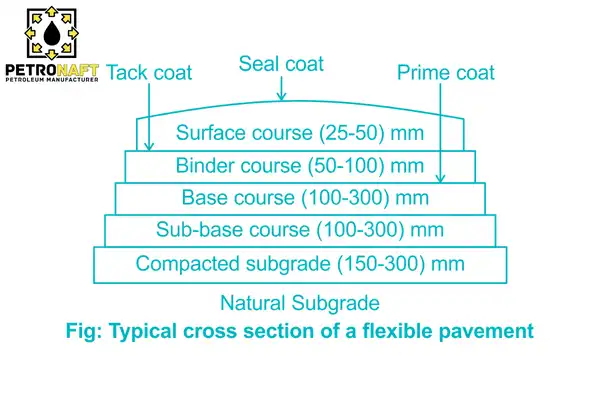Understanding the Prime Coat Tack Coat
Road construction involves several intricate steps, each contributing to the durability, functionality, and longevity of the finished roadway. An integral part of this process involves the application of various asphaltic binding layers, specifically prime coats and tack coats. Both these coats, though used at different stages of construction and for distinct purposes, play a pivotal role in ensuring the structural integrity of the road. By understanding their composition, application, and function, we can better appreciate the complexity of road construction and the careful planning required to build roads that are not only smooth and efficient, but also stand the test of time.
Content Overview
What is Prime Coat?
In road construction, a prime coat is an application of a low-viscosity binder to a non-bituminous (typically granular) base layer, such as a sub-grade or base course. This prime coat is designed to penetrate into the base layer and provide a sealed surface, to prevent the ingress of moisture and to provide a solid, adherent surface for the subsequent asphalt layers.
The prime coat has several functions:
Moisture Barrier: It provides a waterproof layer that prevents moisture from infiltrating into the pavement structure. This is important because excessive moisture can weaken the pavement structure, leading to failure.
Binding Loose Particles: The prime coat can bind together the top layer of the base, creating a stronger and more stable surface for the next layer of pavement.
Adhesion: It promotes adhesion between the base layer and the first layer of asphalt. Without a prime coat, the asphalt could delaminate from the base, reducing the lifespan of the road.
Preparation of Base Surface: It helps to harden the top surface of the base layer and prepare it for the laying of an asphalt layer.
The prime coat is typically composed of a cutback bitumen or emulsified asphalt, which is applied and allowed to cure before the asphalt layers are laid. It’s crucial to remember that the prime coat needs time to cure properly, so it’s often applied well in advance of the asphalt layers. The exact specifications for the prime coat will vary depending on the project requirements, the local climate, and the materials used in the pavement structure.
How To Calculate Prime Coat Quantity?
Prime coat is applied to a gravel base before a layer of hot mix asphalt is laid, and it helps to bond the layers of a pavement system together. It’s typically applied at a higher rate than a tack coat, typically between 0.6 and 1.2 liters per square meter (l/m²), depending on the type of soil, moisture conditions, and the type of prime coat used.
To calculate the quantity of prime coat you will need for a job, you use the formula:
Prime Coat Quantity = Application Rate * Area
Let’s calculate how much prime coat we need for a 1000 square meter area. We will use an average application rate of 0.9 l/m² as an example:
Prime Coat Quantity = Application Rate * Area = 0.9 l/m² * 1000 m² = 900 liters
Keep in mind that the actual rate can vary based on a number of factors, such as the type and condition of the existing surface, the type of prime coat, weather conditions, and so on. Always consult with a paving professional or the manufacturer’s guidelines to ensure you’re using the right rate for your specific project.
Also, as with tack coats, prime coats are typically measured in gallons in the United States, so you may need to convert your measurements if you are using the Imperial system.
What is Tack Coat?
A tack coat in road construction is a thin layer of asphalt emulsion that is applied to an existing asphalt or concrete surface before a new layer of asphalt is laid. This coat serves to create a strong adhesive bond between the old and new pavement layers, helping them work together as a single unit when under loads. It’s also crucial in preventing the layers from slipping against each other, especially under the shear stress from braking or accelerating vehicles.
Here are some of the key functions of a tack coat:
Bonding: The tack coat promotes adhesion between the existing surface and the new layer of asphalt. This helps prevent slippage and delamination between the layers.
Waterproofing: It can provide an additional barrier against water infiltration between the layers of pavement, reducing the potential for moisture-induced damage.
Strength: By ensuring that the pavement layers work together as a single unit, the tack coat can increase the overall structural strength of the roadway.
The tack coat is typically applied as a spray of asphalt emulsion. The amount and type of emulsion used can vary depending on factors such as the type of asphalt being used, the condition of the existing surface, and the expected loads on the pavement. It’s also important that the tack coat is given sufficient time to “break” or cure before the new asphalt layer is laid, as premature placement can lead to issues like slippage or bleeding.
How To Calculate Tack Coat Quantity?
Tack coat is a light application of asphalt emulsion between hot mix asphalt layers designed to create a strong adhesive bond without slippage. Here’s how you can calculate the quantity of tack coat you will need for a particular job. The formula for the application rate is:
Application Rate = Volume/Area
The tack coat should be applied at a rate typically ranging between 0.05 and 0.25 liters per square meter (l/m²), depending on the condition of the existing surface and the type of tack coat used.
Let’s calculate how much tack coat we need for a 1000 square meter area. We will use an average application rate of 0.1 l/m² as an example.
Tack Coat Quantity = Application Rate * Area = 0.1 l/m² * 1000 m² = 100 liters
Keep in mind that the actual rate can vary based on a number of factors, such as the type and condition of the existing surface, the type of tack coat, weather conditions, and so on. Always consult with a paving professional or the manufacturer’s guidelines to ensure you’re using the right rate for your specific project.
Also, note that the application rate is in liters per square meter for liquid form. For emulsified asphalts, you will need to consider the residual asphalt content (which is typically around 50-65% of the emulsion). So, if you have an emulsion, the volume of emulsion required will be roughly double.
Lastly, tack coats are normally measured in gallons in the United States, so you may need to convert your measurements if you are using the Imperial system.

The differences between Tack Coat and Prime Coat
Prime coats and tack coats are both used in road construction but serve different purposes and are applied at different stages of the process. Here’s a comparison of the two:
Usage and Purpose:
- A prime coat is applied to the base course (the layer directly underneath the pavement) before the first layer of asphalt is laid. Its main purpose is to seal the base course, protect it from moisture, and provide a solid, adhered surface for the asphalt layer.
- A tack coat is applied on top of an existing asphalt or concrete layer before a new layer of asphalt is added. It’s used to ensure strong adhesion between the new and existing pavement layers.
Materials:
- Prime coats are typically made from cutback or emulsified asphalt, which are designed to penetrate into the base layer and seal it.
- Tack coats are generally composed of a thin layer of asphalt emulsion, and their primary goal is to stick to the surface and promote adhesion with the new asphalt layer.
Application:
- Prime coats are used on granular, non-bituminous base layers, such as a sub-grade or base course, and require time to cure before the asphalt is laid.
- Tack coats are applied to existing asphalt or concrete surfaces and also require time to cure before the new asphalt layer is added.
Tack Coat and Prime Coat are used in order to both fill the voids and cover the asphalt surface, as was previously discussed. Spreading a layer of low or medium-hardness liquid bitumen over the sandy surface of the road is referred to as Prime Coating. Spreading a layer of asphalt or concrete on the surface of the road is referred to as Surface Coating or Tack Coating.
Emulsified bitumen CRS-1 and CRS-2 are types of bitumen that, due to their high rate of emulsion break, are commonly used as Tack Coat bitumen. This is because their fast “breaking” speed allows them to be ready for application quickly, ensuring timely progress on construction projects.
For Prime Coat application, a range of bitumen types can be deployed depending on various conditions. For instance, in colder climates, RC-70 bitumen is often employed, whereas in temperate climates, MC-70 bitumen may be used. In warmer climates, SC-70 bitumen is typically the go-to choice. However, these selections are not hard-and-fast rules and should be adapted to local conditions, material availability, and project specifications.
It’s essential to note that applying a Prime Coat with emulsion bitumen on non-porous and closed-grained bases is not advisable. Since the purpose of the Prime Coat is to penetrate and seal the base layer, applying it to non-porous surfaces may lead to ineffective sealing, as the bitumen might fail to permeate the base layer properly, remaining as a thin film on the surface instead.
The main objective of applying a Prime Coat is to consolidate the base layer and enhance the strength of the asphalt. Meanwhile, the Tack Coat is intended to create strong adhesion with the final asphalt layer, binding the layers of asphalt together to create a unified, sturdy structure.
In the process of road construction, the Prime Coat is typically applied first, followed by the Tack Coat. The Tack Coat aids in preventing the road surface from becoming slippery, improving traction and overall road safety.
Conclusion
In essence, Prime Coats and Tack Coats are indispensable in road construction, each serving distinct roles at varying stages. The Prime Coat readies and safeguards the base layer, while the Tack Coat fosters strong bonding between asphalt layers. Their collective objective is to consolidate the asphalt, ensuring the road’s structural integrity and durability. Following local construction guidelines and expert consultations remains crucial throughout the process.
Purchasing These Products from Petro Naft
For more detailed information and to purchase these products discussed in this article, please visit the dedicated products pages below. Alternatively, use the various communication channels provided on our site to register your purchase inquiry or take advantage of our expert guidance.
Prepared by the PetroNaft Co. research team.

